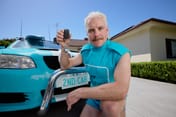
How to keep your battery charged so it’s ready to go when you are.
We often take our cars for granted, assuming they’ll be ready to go whenever we need them. However, car batteries need to be used regularly and will fail if left to sit idle for too long. Here’s our guide to keeping your car battery charged and healthy.
Car batteries are designed to be used regularly. Whenever you keep a car parked for longer than a couple of weeks without use, you run the risk of your battery not having enough charge left to start the car and get you on the road.
Things get pretty stressful if your car won’t start after not being used. You’ll need to jump-start the car yourself (if your battery is a type that allows for this) or call for roadside assistance. If the battery is completely flat you’ll need to replace the battery, which can cost around between $150 and $500 plus installation, depending on the size and age of your car.
How do car batteries work again?
Batteries come in different types and sizes depending on when your car was made as well as its make and size. Electric cars have a completely different battery system to petrol-fuelled vehicles, which is the focus of this information.
In essence, car batteries produce electricity, which is the flow of miniscule negatively charged particles called electrons). The terminals of a car’s battery are connected to all the car parts that need electricity to run, including accessories like windscreen wipers, headlights, music, air conditioning and door locks. Most importantly, your battery is needed for starting the engine.
An alternator is an essential part of the electrical system in your car that replaces the energy that a battery uses on starting the engine. But this doesn't happen immediately. A short trip, or just starting the car and running it for a few minutes is not enough.
In older cars without automatic lights, leaving headlights or inside lights on when the car is switched off will drain the battery quickly as electricity is being used without being recharged.
How do I keep my car’s battery healthy?
The best medicine for car batteries is to be driven regularly. Experts recommend a car be driven at least once every week for a distance of 10 kilometres or more.
Here’s some more detail about how long car batteries last without driving:
Ideally, you won’t leave a car unused for more than a week or two. If your car is going to sit idle for a while, just starting it once a week isn't enough. You might have been told that it’s enough to simply rev the engine a few times but that’s not enough time for the alternator to replace the battery’s charge to a sufficient level.
Similarly, driving a car around the block is not enough. Experts recommend driving for at least 10 kilometres to allow time for recharging. And, if you’re looking at a battery that’s older or already low on charge, it’s best to drive for at least 30 minutes and do most of that on an open road rather than in stop-start traffic.
How often should you start your car for battery good health varies according to your car and the battery. An older car will need more regular starting and a longer recharging drive than a newer one. A car kept in a garage will be protected from climatic changes more than one parked in the open. Extreme cold or hot temperatures drain batteries more quickly than moderate weather.
What should I do if my unused car won’t start?
The first thing to do is check the basics. Are you using the correct key? For an automatic car, is it in ‘park’ and are you trying to start it while your foot is on the brake? If your car has a manual transmission, have you got your foot depressing the clutch?
Assuming all those basics are fine, it might be a problem with the alternator but the most likely issue is the battery.
Older cars can be jump-started from another car using jumper leads but this isn't an option for newer types of batteries. The best all-round action is to call for roadside assistance. If you’re already a member, you’ll only need to pay if a new battery is required. Otherwise, you’ll need to pay a fee or pay for membership before assistance can be provided.
Is there anything else I should know?
Regular driving aimed at keeping your battery healthy will also help other parts of your cars. Your tyres are less likely to lose pressure or develop ‘flat spots’, the moving parts of your engine will thank you for keeping them lubricated with fluids and, when used regularly, seals are less likely to dry out.
Your car still needs to be serviced and checked even if it’s sat mainly idle. And, when you do drive your car after a break, be sensible and cautious when heading out onto the road so you can be attuned to any noises or issues with the car.
I need a car but don’t drive it often. What should I do?
If your car absolutely needs to sit undriven for longer than a couple of weeks, disconnecting the battery is recommended. Or, you can invest in a battery charger, including the option of a ‘trickle charger’ that supplies a low current charge over a long period of time.
There are other options that might be far more attractive though.
Have you ever considered the option of having your car used by someone else while you don’t need it? It’s a great option for anyone who owns a car but doesn’t need to use it all the time.
| Options | How? |
|---|---|
| Car Sharing | Car sharing allows you to earn money from an idle car. That’s well worth considering given that the cost of owning a car really adds up once you factor in less obvious expenses like registration, insurance and depreciation. |
| Uber Carshare | With Uber Carshare, potential borrowers can see your car online and book using a simple app. There are borrowers keen to rent cars, wagons and vans. You choose when your car is available to book, meaning it will always be there when you need it. There’s heaps of help available (even this guide to what to do in the unlikely event a Uber Carshare vehicle’s battery goes flat during a trip). And, it all comes with the bonus of helping out a neighbour! |
If you want to hear more, here’s eight great reasons to rent out your car via Uber Carshare. And here’s a guide for how to get started.
FAQs
How much driving to keep the battery charged?
Experts recommend driving a car for at least 10 kilometres (and up to 30 minutes) at least once every week. If you find your car battery keeps dying when not in use, it’s a clear sign that you need a new battery.
How do I keep my car battery healthy?
The best medicine for a car battery is regular use! Keep your car battery healthy by driving your car for at least 10 kilometres at least once a week. And, if your car is older and doesn’t do this automatically, make sure you turn off all lights and accessories each time you stop.
How often should I start my car for my battery?
You should start your car at least once a week as car batteries do die if not used. But just starting the car and letting it run in a stationary position is not enough to keep the battery charged. Instead, you need to drive for between 10km and 30 minutes.
How long can a car battery sit without being used?
The length of time a car battery will stay charged without being used varies depending on the age of the car, the age of the battery and the type of battery. Can a car battery go dead from sitting around unused? Yes! On average, experts recommend using a car once a week.
What happens if a car battery sits too long?
If a car battery sits idle too long the charge is gradually used but isn’t recharged by the alternator. A partially flat battery can be recharged with an external start and then driving for at least 30 minutes. However, if too much charge has dissipated, the battery will be completely flat and will need to be replaced.
How do you revive a car battery that has been sitting?
If the battery still has sufficient charge to start the car, experts recommend driving the car (on an open road, not in heavy traffic) for at least 30 minutes. If there is no charge, older cars can be jump-started from another vehicle or you need to call roadside assistance or call a mobile battery service.
Information included in this article is accurate as of 19 Dec 2022.The information published on this blog is of a general nature only and does not consider your personal objectives, financial situation or particular needs. The information published on this site/page should not be relied upon as a substitute for personal financial or professional advice.








